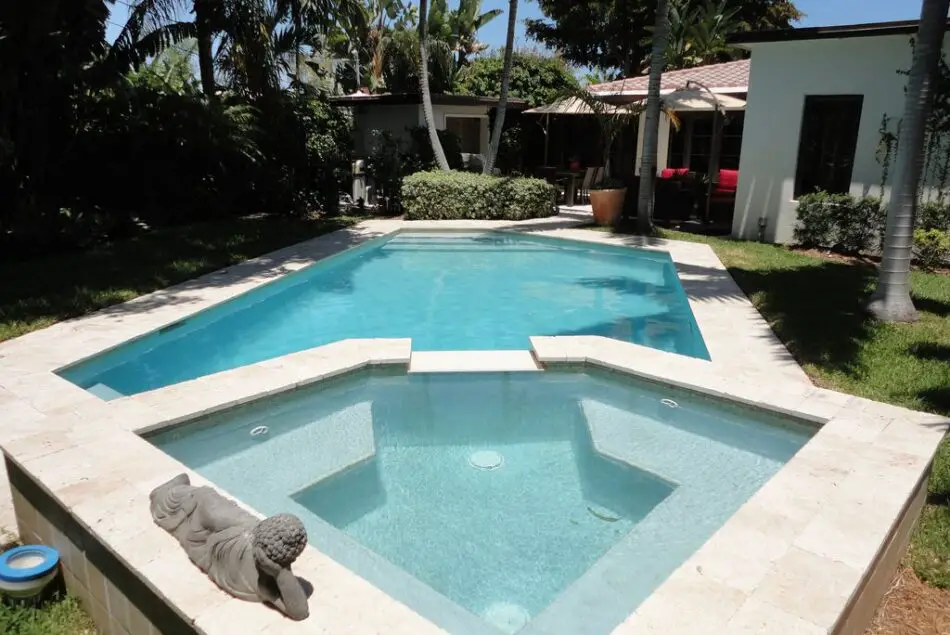
The suggested cyanuric acid level depends on the amount of direct sunlight your pool receives and whether you use a salt chlorine generator.
Test strips are the easiest way to test cyanuric acid in your pool. Cyanuric acid is raised by adding chlorine stabilizer containing cyanuric acid. The only way to lower cyanuric acid is by replacing water.
Unlike free chlorine, cyanuric acid levels should remain level day-to-day. An exception might be if there is a heavy rain storm through which your pool is left uncovered. The rain will introduce a substantial amount of fresh water to your pool, which may dilute the concentration of cyanuric acid. You should always test your pool’s chemistry after such an event.
Test strips are the easiest way to test cyanuric acid. It’s important to get test strips to that include a test for cyanuric acid, especially if you have a hot tub. To learn more about why it’s important to keep cyanuric acid levels low in hot tubs, check out What is the Right Cyanuric Acid Level for Swimming Pools and Hot Tubs?

The suggested cyanuric acid level depends on the amount of direct sunlight your pool receives and whether you use a salt chlorine generator.
To test your cyanuric acid levels with a test strip, follow the instructions on the test strip case. Typically, you will need to submerge the strip in your pool for a minimum number of seconds. Then, you will need to wait some time for the water to react with the reagents on the strip. Finally, you will compare the color of the cyanuric acid test on the strip with the range of colors on the test strip package to get an estimate of the amount of cyanuric acid in your pool.
You may use a test kit to test your free chlorine and pH levels. The test kit may come with a cyanuric test as well. However, cyanuric acid is less critical to measure exactly than free chlorine or pH. It also does not need to be tested as often. Once per week is plenty. Therefore, test strips should suffice for most every need of pool owners and pool professionals alike
Cyanuric acid levels are raised by adding pool stabilizer. It’s called stabilizer because cyanuric acid stabilizes free chlorine from being evaporated by the sun. For more information, check out The Relationship Between Swimming Pool Chlorine and Cyanuric Acid.
Many chlorine products come with stabilizer already mixed in. Adding a chlorine solution with stabilizer will automatically raise your cyanuric acid levels. However, liquid and granular stabilizer solutions may be purchased and added separately
The only practical way to lower cyanuric acid is by replacing some of your existing water with fresh water. To calculate how much water should be replaced, subtract the desired concentration of cyanuric acid from the current concentration and divide the difference by the current concentration.
For example, if your pool has a current cyanuric acid concentration of 80 ppm and you would like it to be 60 ppm, then you would replace 25% of your pool’s current water with fresh water. As long as your cyanuric acid is at a reasonable level (e.g. less than 100 ppm), you may find it more convenient to raise free chlorine than replace water. The Pool Calculator application can help you figure out just how much chlorine you need to add given your cyanuric acid level.

Want to learn more about algaecide? Read on to find out when to add algaecide to your pool maintenance routine and other helpful tips.

In this quick guide, we’ll answer the question “can you over shock a pool” and unveil the factors to consider when shocking a pool.

Maintaining both pH and total alkalinity in your swimming pool is important for keeping your pool properly sanitized and non-corrosive. Total alkalinity is to pH what cyanuric acid is to free chlorine. Total alkalinity stabilizes pH levels. The ideal pool pH level is 7.4 to 7.6. The ideal total alkalinity level is 80 to 120 ppm.

The Association of Pool and Spa Professionals recommends free chlorine levels for both swimming pools and hot tubs be kept between 2.0 and 4.0 ppm. However, the Center for Disease Control recommends free chlorine stay above 1 ppm in pools and 3 ppm in hot tubs.